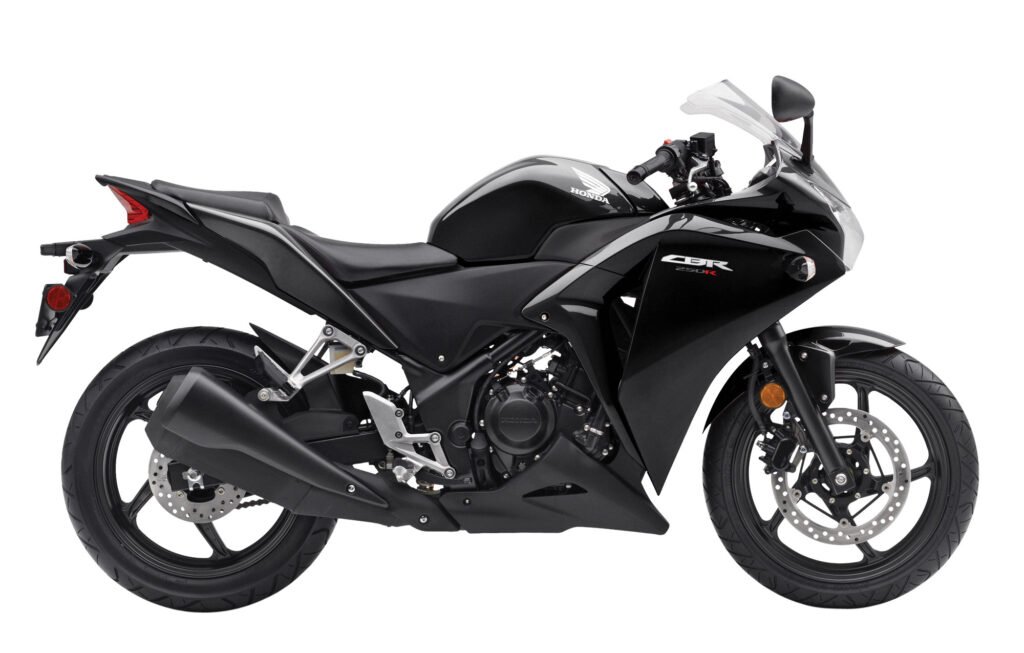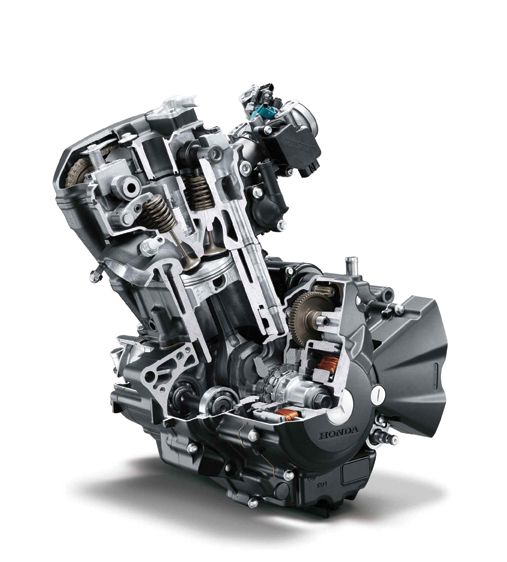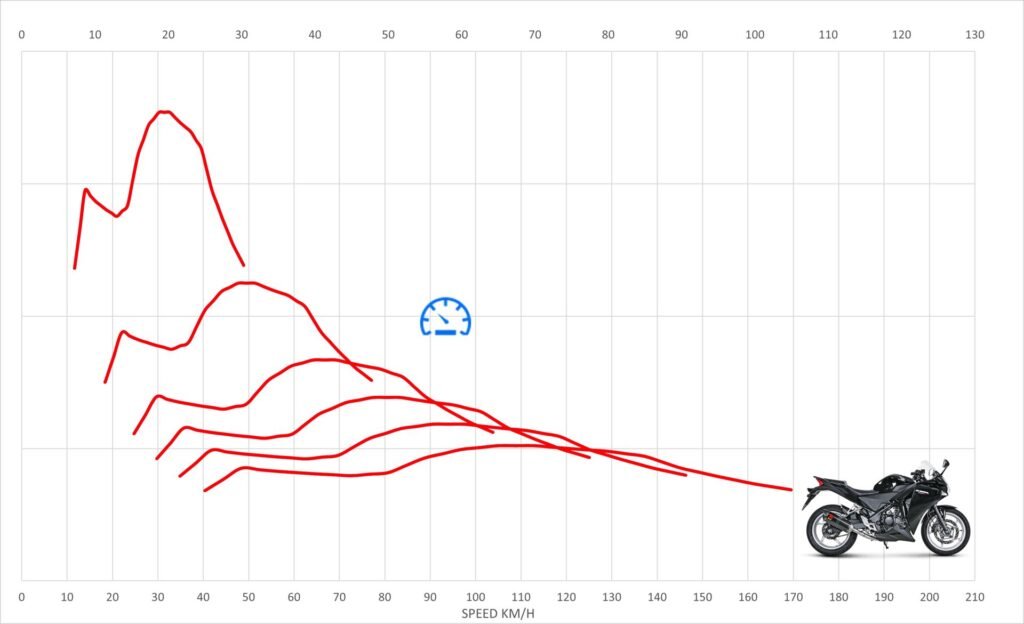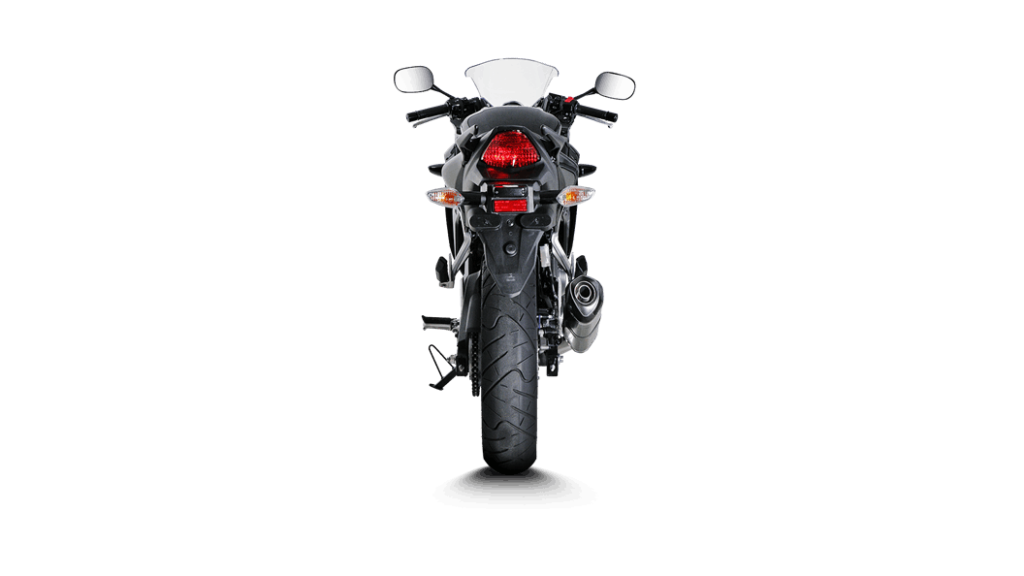Honda CBR250R 0-60 mph in 7.10 seconds
Honda rejoined the entry-level sportbike class back in 2011 with the introduction of its CBR250R.
This was a motorcycle sold in all markets and was aimed at new riders who wanted a sport-looking motorcycle that made a good all-around commuter but was also reasonably priced.
The Honda CBR250R in my view is not the best-looking motorcycle and was conceived in an era where Honda released some aesthetically challenging-looking motorcycles which were very Asimo-looking in my opinion.
Honda has traditionally been the most conservative of the big motorcycle brands.
But from time to time they do come out with something bonkers like the Honda NR750 or the most recent Honda CBR1000RR-R.
The Honda CBR250R is very much in line with the conservative side of the Honda bipolar design team of that era.
It’s powered by a small and compact 249 cc single-cylinder engine that produces a claimed 26 horsepower at a lowly 85000 rpm.
The peak claimed torque output of 16.8 ft/lb is delivered at 7000 rpm.

The Honda CBR250R weighs in as one of the lighter models in the class at 168 kg wet. Both numbers combined do not really set the world on fire.
Since 2012 the market has changed somewhat with there being a kind of arms race to offer more powerful entry-level motorcycles.
There are many reasons for this but it’s mostly down to the ever-evolving learner licensing laws in many markets.
These changing laws have also meant that the ‘entry-level’ class of motorcycle is not as clearly defined as it used to be via the engine capacity alone.
We now see motorcycles up to a very ‘middleweight’ 660 cc that makes up the ‘entry-level’ motorcycle category.
There are also some of the 500 cc plus motorcycles that occupy this class are restricted.
These 500 cc plus restricted models are restricted so that they meet power and/or power-to-weight ratio limits such as A2 or LAMS-restricted motorcycles.

The Honda CBR250R’s engine capacity is only 250 cc bike and is full power and not restricted in any way like many of the 500 cc plus motorcycles that to a degree compete against it..
As a prospective new motorcyclist, you have many great choices of motorcycles to pick from offered by many brands.
As an example, If you like Honda’s you can opt for a CBR150R, CBR250R, CBR250RR,CBR300R,CBR500 and CBR650R.
Those are just a few that you can choose from. It’s a minefield for sure!
The Honda CBR250R has been, and still is a massively popular motorcycle but as times have changed it has become a less compelling option since the CBR300R arrived as well as the CBR500RR.
There are a large number of competitors that have an array of options too, that at least from a performance perspective offer much more than the outgoing Honda CBR250R.
With the huge number of alternatives, how does the modest Honda CBR250R stack up from a performance perspective today?

Honda CBR250R Dyno Chart
The Honda CBR250R makes a respectable 23 horsepower at 8500 rpm and 16 ft/lb @ 6500 rpm.
The power delivery is typical of a small capacity average revving single-cylinder engine.
Most of the usable part of your performance sits between 5000 and 8000 rpm.
The above does not mean to say that below 5000 rpm there is no usable power, it’s just that when we are talking about a peak of 23 horsepower.
So at 5000 rpm you only have around 12.5 horsepower available to you!
With such little power, you’re not going to drive it in 4th gear from 3000rpm and get anywhere fast so using lower gears with rpm above 5000 is the place this motorcycle is happiest.
If you keep the engine above 5000 rpm and below 8000 rpm you make decent progress without causing the engine to feel like it is overworked and under-delivering.

Revving the engine beyond 9500 rpm and to 10,500 will still make the bike move but you can shift a little earlier and not hurt your progress.
By doing so you can in fact improve acceleration by short-shifting gears when going for it..
We, of course, have not tested all the motorcycles in the entry-level class but of those we have tested, it is only the Suzuki GSX250R that has a worse engine performance.
Granted, that is the only other 250 we have tested along with the Ninja 250R which quite frankly has a better-performing engine.
The reason why the Kawasaki Ninja 250 overall is a better engine is down to the advantage of having an extra cylinder, which helps it to rev higher and hold onto its power.
The Honda CBR250R is more competitive with Kawasaki Ninja 250R below 8000 rpm but struggles beyond!

Honda CBR250R 0-100 km/h in 7.63 seconds
It is not all bad for the Honda CBR250R despite it not being a performance-orientated engine.
As the Honda CBR250R can still accelerate from 0-60 mph in 7.10 seconds. If in isolation, this is objectively quick, though it requires 3rd gear and two gear changes to hit 60 mph.
This is pretty much the optimum 0-60mph time for this motorcycle in most hands.
The majority of reasonably sized and weighted people with decent enough skills will be doing eight-second runs.
Speed in gears at 5000 rpm
| Speed at 5000 rpm | GSX250R | Ninja 250R | CBR 250R |
| First | 14.3 mph | 13.9 mph | 14.5 mph |
| Second | 22.6 mph | 20.2 mph | 22.8 mph |
| Third | 29.2 mph | 25.7 mph | 30.7 mph |
| Fourth | 33.1 mph | 31.2 mph | 37 mph |
| Fifth | 38 mph | 36.2 mph | 43.3 mph |
| Sixth | 42.8 mph | 40.6 mph | 50.1 mph |
You must not use the clutch when changing gears as you’ll definitely add a few tenths to your time!
This is especially important for small-capacity low-power machines that require more gear changes to reach equivalent speeds
Below 70 mph or the first four gears is the best operating range for the Honda CBR250R.
This is not because the Honda CBR250R is inferior to competitors, but just a simple fact that it’s only a 250 cc motorcycle with 23 horsepower.
You’ll be in those mentioned gears mostly around town and on slower country roads.
Once you hook into fifth gear the Honda CBR250RR starts to run out of steam objectively and compared to its rivals but it still gradually accelerates at an acceptable rate.

If you get your 0-30 and 0-60 mph time close to the optimum of under eight seconds….
keep feeding the little Honda CBR250R gears ensuring that you are in maximum tuck, and you can expect the quarter mile time for the Honda CBR250R to be achieved in 15.86 seconds @ 81 mph.
It is a decent time for such a low-powered, and small capacity motorcycle.
In terms of elapsed time, anything under 16 seconds is as good as many small-capacity turbocharged entry-level cars can muster. So not a bad effort from the Honda CBR250R.
The Honda CBR250R will have a slightly lower terminal speed due to getting off the line a little quicker but accelerating a little slower up top compared to many cars that match it in the quarter mile..
Again though, these are optimum times. Most people will be doing mid-sixteen seconds with a terminal speed of around 75 mph.

Top speed is very much dependent on how large you are and how windy it is.
This is the case for all motorcycles, but the less power a motorcycle has the more the rider’s size and weight will impact the performance numbers.
Honda CBR250R Top Speed 93 mph
We managed a top speed of 93 mph on the Honda CBR250R which took an astronomical 97 seconds to get to.
A more realistic top speed for most people will be around 90 mph which the Honda CBR250R can get to in around 25 seconds from a standing start.
If you’re not in a full MotoGP racer tuck, you can expect around 85 mph at best from the Honda CBR250R.
You personally may get more or less top speed, though it is dependent on the formerly mentioned factors.
90 mph is a realistic top speed for the Honda CBR250R for most people unless you have an exceptionally long and straight road.
The Honda CBR250 back in 2011, while still not top of the performance pile was more or less matched with its other playmates in its class.
Now though, as mentioned there are many faster options that fall in the loosely defined class.
If you want the maximum performance 250, the Honda CBR250R is not the best choice, as there are far more capable alternatives offered.
Even Honda offers better alternatives as well as many rival brands too.
If you must have a sporty entry-level Honda and want to race your friends on rival bikes, then the CBR300R or CBR500R are better straight-line performance choices than the CBR250R.
Alternatively, the new Honda CBR250RR is a high-performance four-cylinder 250, though this motorcycle is not available in all markets.
Honda CBR250R Acceleration
| Honda CBR250R Acceleration | |
| Speed | Time |
| 0-10 mph | 0.72 |
| 0-20 mph | 1.46 |
| 0-30 mph | 2.24 |
| 0-40 mph | 3.49 |
| 0-50 mph | 5.10 |
| 0-60 mph | 7.10 |
| 0-70 mph | 10.17 |
| 0-80 mph | 15.19 |
| 0-90 mph | 26.476 |
| SS/QM | 15.86/81.2 mph |
| SS/KM | 31.14/91 mph |
| SS/Mile | 45.599/92 mph |
| Top Speed | 93.3 mph |











